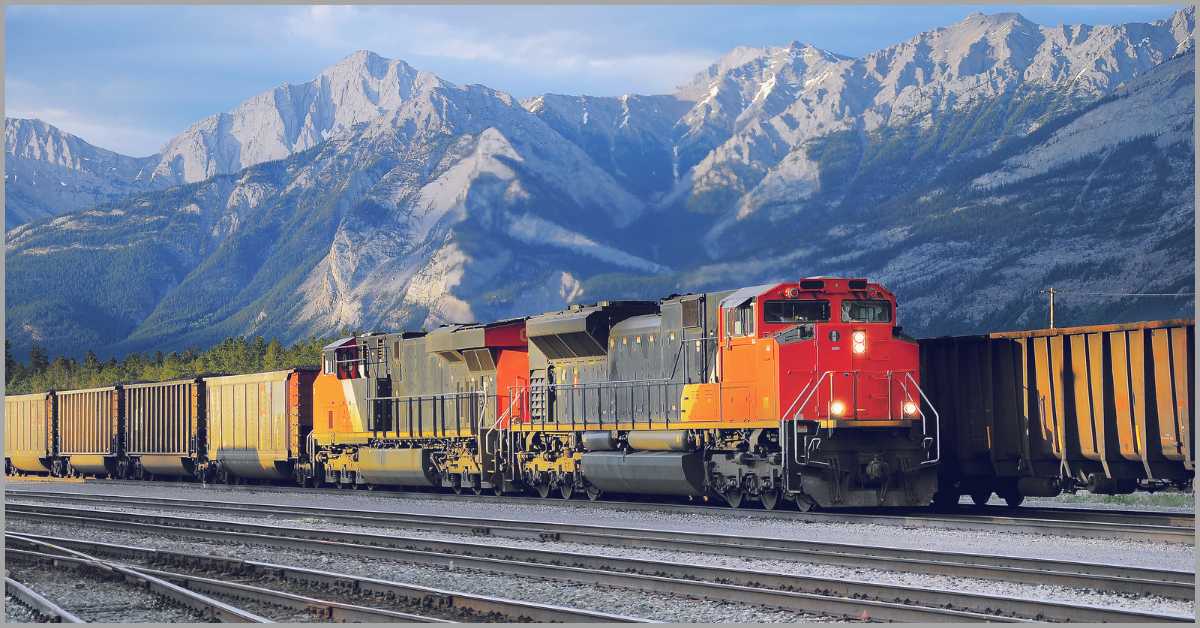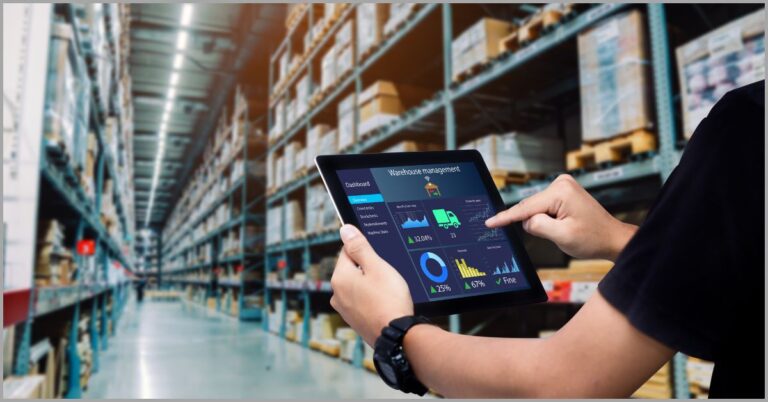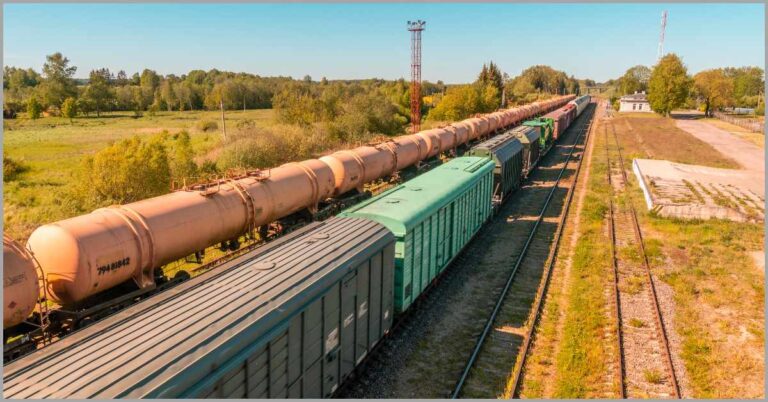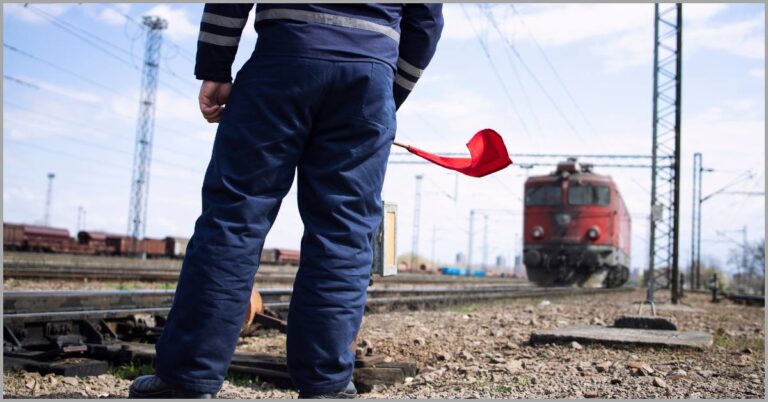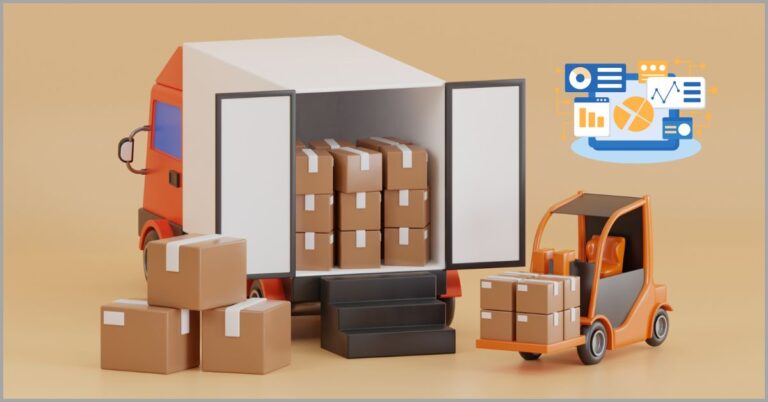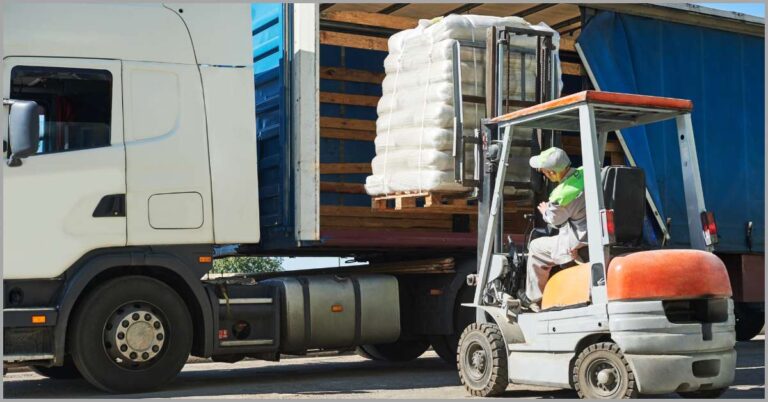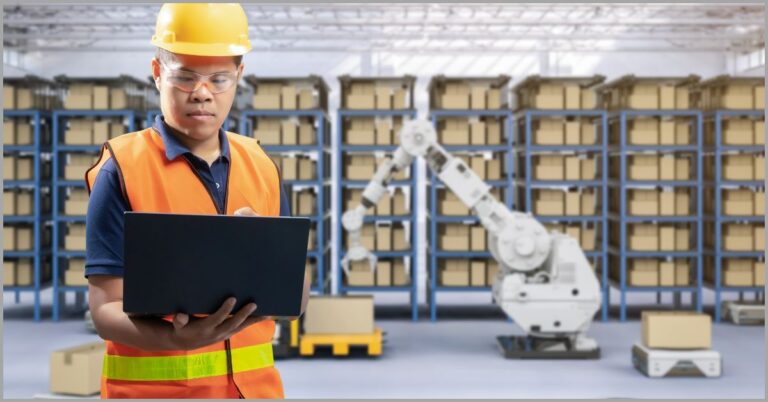What is Rail Transloading? An Essential for Efficient Overland Shipping in 2024
Want to improve your overland shipping strategy?
One great thing about effective railroad logistics is carrier diversification.
When you’re dependent on just one rail carrier, you have extremely low negotiating power, and this can lead to higher carrier charges.
In 2024, at least 89% of shippers diversified their carriers, according to a OneTrac survey. They achieved huge cost-savings because of it.
Rail transloading can break the monopoly of a single transporter, especially if you choose a rail transload facility served by multiple rail carriers. This enables you to switch your cargo to the rail company that offers the best rates.
By enabling a multi-carrier strategy during rail shipping, this also means greater resilience since you’ll have alternative options if one carrier is unavailable.
If you’d like to learn more about enhancing your business’s supply chain, check out this article I wrote about warehouse management statistics for improving logistics.
In this article, we’ll discuss what rail transloading is, and why it’s essential for efficient overland shipping in 2024 so that you can streamline shipping for your business.
Let’s get started.
What is rail transloading?
So what is rail transloading?
It is a form of overland shipping that creates a bridge between trucking and rail freight services. In other words, it involves the transfer of cargo between trucks and rail cars, or even the switching of cargo from one rail car to another.
In cases when trucking is unideal, such as where there are traffic jams or weight restrictions, rail transloading provides more efficient freight transportation.
With rail freight less susceptible to traffic jams, they become the more ideal solution in this case if you’re looking to get around road congestion. You can also use it to bypass road constructions, poor weather conditions and other obstacles.
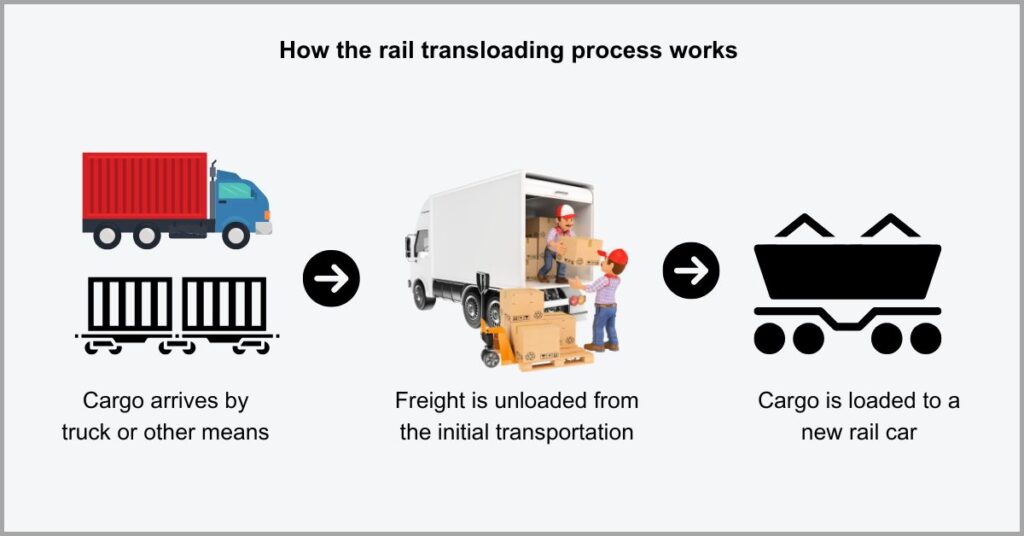
Rail transloading typically takes place at a dedicated rail transload facility. Here, you’ll find dedicated personnel, encompassing transload operators, switchmen, and even brakemen, among others.
If you run a transload yard, leveraging a transload yard management system is the way to go to improve inventory management and enhance efficiency for your facility.
Click here to start your free transloads.co trial to use our platform to improve logistics for your railroad transloading services.
With our platform, you’ll get several important features like a demurrage clock for monitoring empty rail cars, automated barcode inventory scanning, and real-time shipment monitoring, all of which improve efficiency for your rail transload yard.
Commodities that are suitable for rail transloading
1. Mineral and aggregate
Do you often need to transport minerals and aggregates?
When you’re moving mined raw materials like coal and iron ore, trucking may not be ideal because it typically attracts higher per ton per mile expenses.
So shipping minerals and aggregates via trucks can be very expensive, with rail proving the most cost-effective solution for long-distance hauling.
In fact, $0.160 per ton per mile is the cost of moving freight by rail, according to a study by Costmine Intelligence. Trucking, meanwhile, can invite expenses of up to $3 per ton per mile depending on various unique factors.
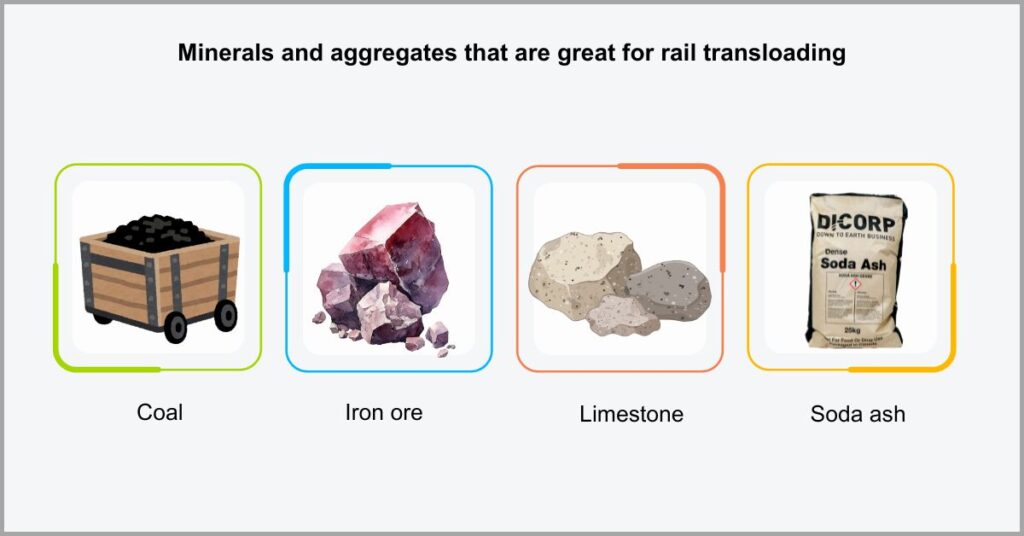
With rail shipping clearly the more economical option, it proves a great strategy for moving minerals and aggregates, particularly large quantities of coal and iron ore.
If you’re looking to transload these goods by rail, you’ll probably need to move them by dump truck first from the mining site. The best transload service companies may even take care of this first-mile delivery for you to ensure more efficient shipping.
At the raid transload facility, they’ll then offload the minerals and aggregates from the truck and onto the railcars. It’s likely that your transload shipping partner will use conveyor technology to enable efficient cargo transfers and minimize spills.
2. Cereal grains
Grain transportation can also be challenging.
If you’re looking to transport corn products, oat and wheat, chances are that truck shipping may not be the most economical way to do it.
With trucks often limiting the amount of cargo you can carry at a time, you’ll need to perform multiple shipments therefore increasing expenses.
In 2023, approximately 80.5% of EU road freight transportation was carried out by trucks with an average load capacity of 20.6 tonnes. If I crunch the numbers, this translates to at least 45,415 pounds in terms of cargo capacity for each truck.
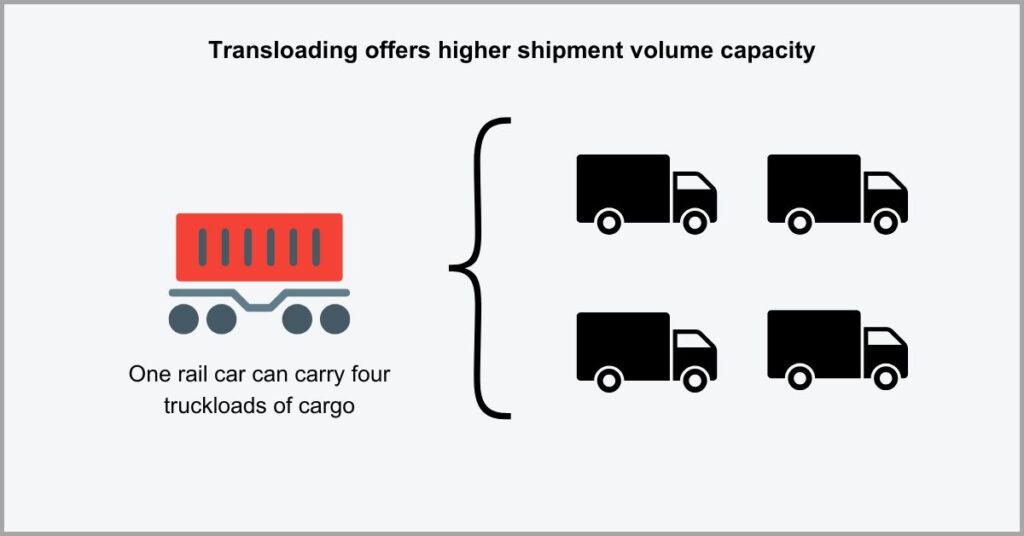
Considering the average rail car can carry up to 200,000 pounds, it’s clear that you can move over four truckloads worth of cargo with a single rail car.
It is precisely for this reason that transloading and through trailer carriers will switch your freight over to rail if you’re looking to move large amounts of cereals and grains overland in order to ensure higher shipping cost efficiency.
Another reason why rail transloading is great for cereal grains is the fact that these types of commodities are usually very heavy, with rail more suitable for heavy cargo.
3. Liquid bulk
Are you transporting liquid bulk over long distances?
Besides trailer tankers having less capacity than rail tankers, trucks may also not be a great fit in remote locations with poor road networks.
With products like crude often mined far from necessary infrastructure, rail enables you to overcome geographical barriers to transport oil to refineries.
There are 140,000 miles worth of rail network in the US, according to a study by the ASCE. This makes it possible to reach far-flung oil fields and other typical remote locations where you may be sourcing liquid bulk raw materials.
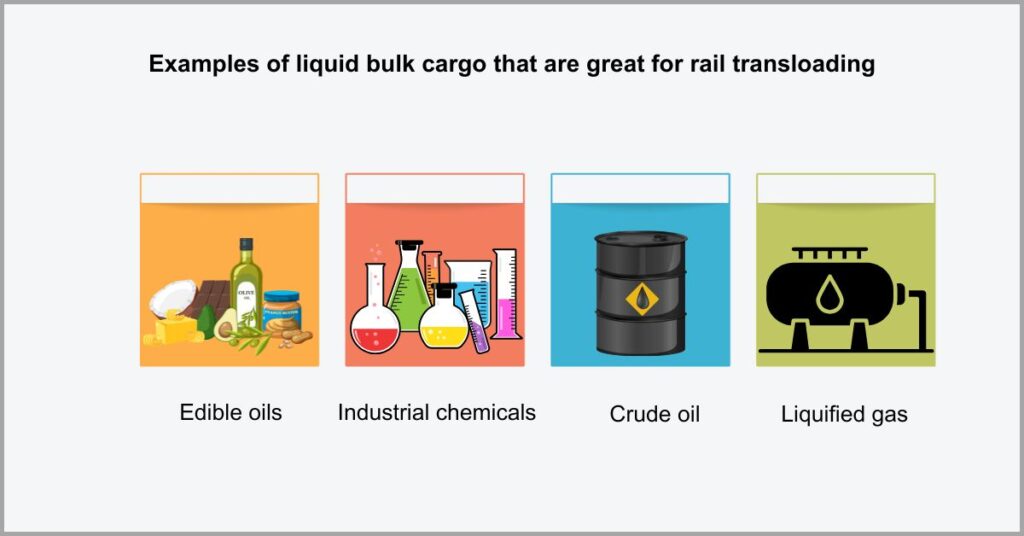
In terms of how it works, your rail transloader will first deliver the crude oil, for example, using a truck tanker to the nearest rail transload facility.
Here, they’ll perform transloading freight operations, where they’ll offload your cargo onto a rail tanker. Metering systems, loading racks and other specialized equipment will typically be roped in to make the transfer efficient and to minimize spills.
After the transloading process is complete, some may offer you blending services like precision mixing where they’ll create specific products to meet your market’s needs. This gives you even more return-on-investment from rail transload shipping.
4. Oversized goods
Looking to move oversized commodities?
Shipping oversized goods like construction vehicles and giant wind turbines can be challenging. This is because such goods increase the risk of damaging road infrastructure while they also pose a great danger to other road users.
So rail transloading is a great way to overcome the increased risk of handling oversized cargo as well as weight restrictions across various jurisdictions.
A PubMed study revealed that 80% of truck accidents result from overloading. It further underscores the importance of rail transloading, which can help lower such incidents and improve the safety of oversized freight transportation.
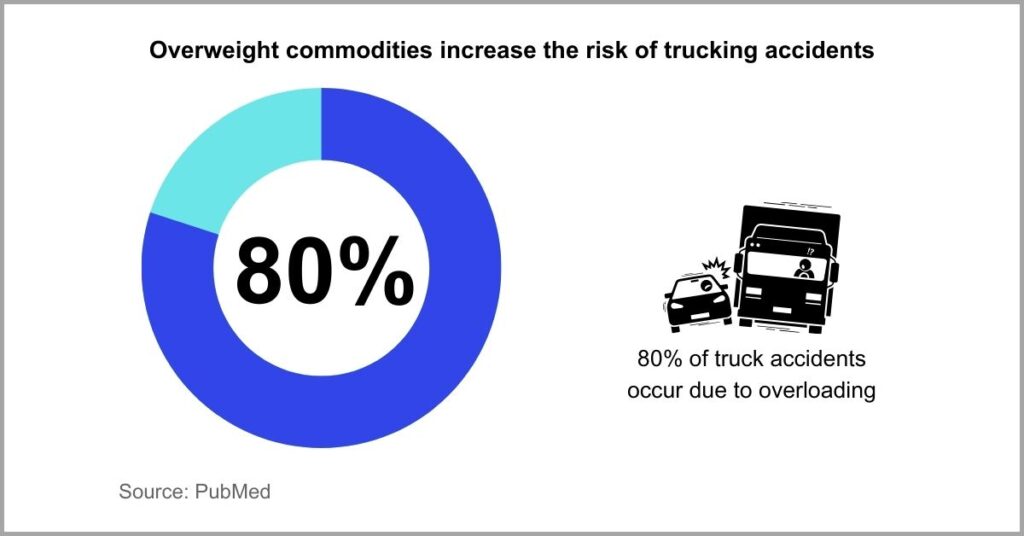
This is because rail transloading is very suitable for overweight freight shipping.
In cases where goods have unusual weights and dimensions, rail offers transportation that has greater capacity to handle the increased load compared to trucks.
With some wind turbines being as long as 80 meters or more, rail can accommodate these goods as long as effective railcar switching is performed and your transload facility also coordinates the shipping process strategically.
Moreover, with rail transloading involving dedicated infrastructure away from other road users, it reduces the risk and dangers of overloading and moving large freight by truck.
5. Refrigerated cargo
Transloading refrigerated cargo attracts unique concerns.
For instance, if your cargo is left on the loading dock for too long, it can get exposed to the wrong temperatures which lowers the integrity of the shipment.
So poor handling of refrigerated cargo can therefore increase the risk of cargo rejection, while you may also be held liable for damages by consignees.
A FlockFreight study showed that 86% of shippers were forced to replace damaged cargo in 2023. Some of these replacement issues resulted from the poor handling of refrigerated cargo.
With refrigerated rail transload facilities, you can access specialized services that ensure the safe handling of cold chain products.
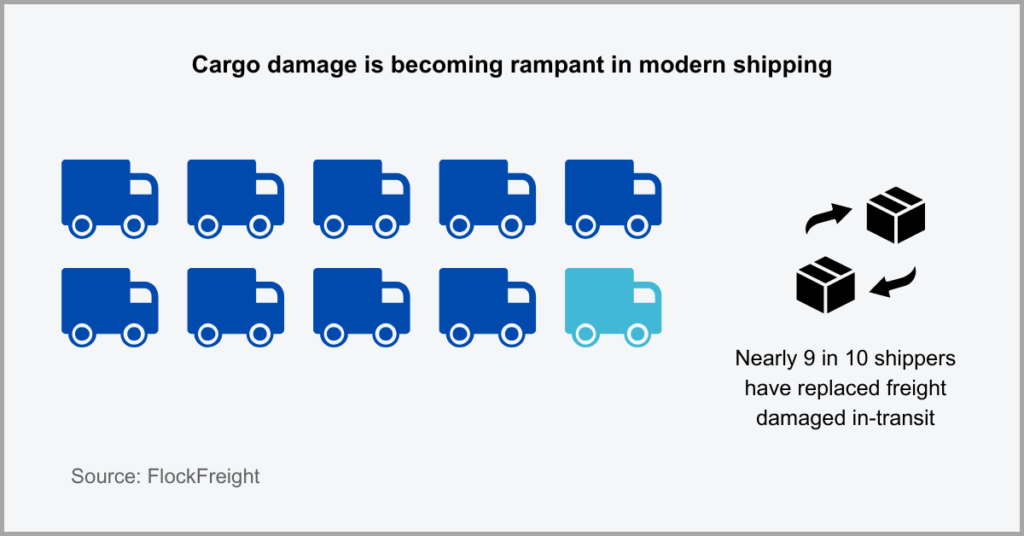
For instance, your rail transload facility can provide various cold storage facilities. These help ensure that the cargo remains at the correct temperatures during the entire freight transfer process.
You can even get refrigerated rail boxcars for transportation, which is why rail shipping is among popular freight brokerage strategies for cold chain logistics. It can ensure cargo arrives at its destination at the right temperatures needed for cargo acceptance.
So if you’re looking to move refrigerated cargo such as food products, pharmaceuticals and flowers, rail transloading is one of the best forms of transloading to consider.
Challenges of rail transloading
a) Poor railcar tracking
Poor visibility is a huge threat in rail transload yards.
This makes it challenging to determine when a rail car was placed on the track, which attracts demurrage risks from the rail company.
Additionally, you can also experience shipping delays resulting from slow transloading operations because of poor empty railcar tracking.
An ACD survey revealed that 31% of shippers paid high demurrage costs in 2023. Some of the leading factors behind this were inefficiencies and poor empty railcar tracking, which lead to transloaders holding up rail cars beyond their free time.
When this happens, these demurrage costs can be passed onto you as the shipper.
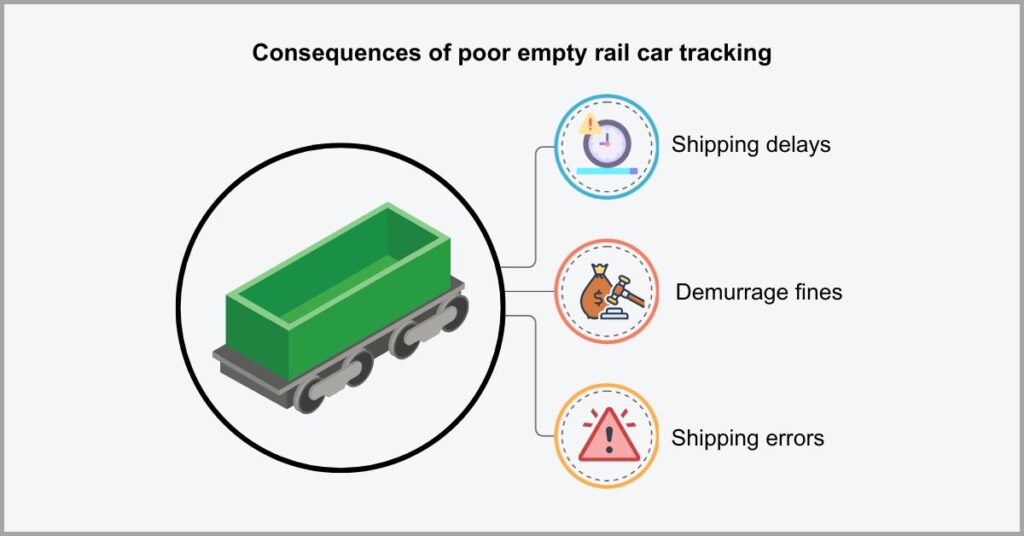
By improving empty rail car tracking, it became easier to lower the risk of demurrage by ensuring that railcars go back to the rail company on time. Additionally, it also makes it easier for transload operators to fulfill orders more promptly.
I recommend using proven transload management software such as transloads.co to improve the visibility of rail yard assets.
Click here to start your free transloads.co trial to get vital track management features.
With our platform, you can track inbound and outbound rail cars more efficiently to improve your rail transload shipping processes and lower turnaround times.
b) Ineffective railcar switching
What is railcar switching when it comes to shipping?
It simply refers to the process by which the transload operator transfers your cargo from one rail car and into an empty or partially loaded outbound rail car.
When railcar switching is poor and highly inefficient, this can also lead to your cargo being held up in a rail transload yard for longer than is necessary.
A SageJournal study established rail cars spend 62% of their time in rail classification yards. So very little of that time is spent actually hauling your freight to its destination, which is another reason for rail shipping delays.
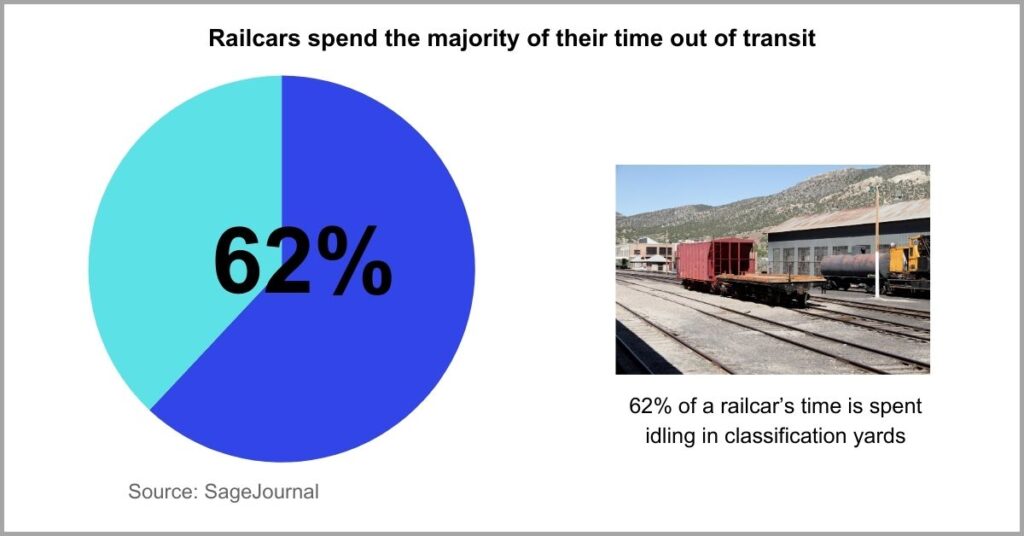
If you’d like to get around this, I also recommend improving switchman communications to enhance the coordination of loading and unloading processes.
Other strategies for more effective railroad logistics and switching operations include improving how you calculate estimated arrival times of freight so you can prepare loading docks accordingly.
It’s also prudent to perform regular and proactive rail maintenance, covering the inspection and servicing of switches, crossing equipment and other infrastructure.
Doing this will reduce incidents of rail derailment and rail transload worker injuries, thus eliminating disruptions and enabling safer and quicker railcar switching processes.
c) Low time & location flexibility
Unexpected orders can come in for your business.
Rail freight shipping, however, may not be able to handle these spontaneous transloading requests because these trains typically have a strict timetable to follow.
What’s more, rail transloading may require access to special facilities with rail sidings, which can also result in an increase in transportation distance.
A survey by Breakthrough reavelead 40% of carriers are looking to optimize rail routes to reduce travel distance. This is sometimes difficult to achieve with rail transloading because of the need for special infrastructure that’s only available at select facilities.
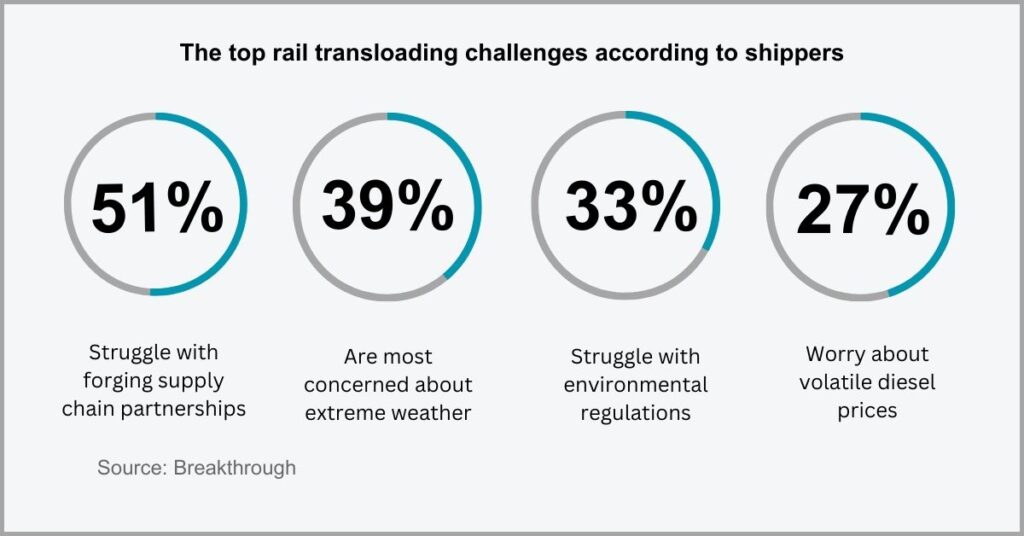
In order to make shipping more time and location flexible, the need arises to bridge rail with other forms of transloading such as trucking, for example.
This is where you’ll need to make a choice between other strategies for shipping your freight like choosing between road transloading and transshipment, which can leverage trucking to create connections in areas that lack direct rail shipping lines.
So in case you get an urgent order out of the blues, you can get around the need to use rail transportation via truck-to-truck transloading to move your freight to a target market in a more timely manner to beat spontaneous deadlines.
How to choose a rail transload facility
I. Consider proximity to receivers
It’s important to keep in mind your destination.
Evaluating distance to receivers is a vital criteria because it can directly affect cost-savings.
For example, rail transload facilities that are far away from your receivers can attract extra trucking needs for your business, which means additional costs.
So you want to keep in mind all the consignees the shipment is going out to so that you can choose a rail transloading or intermodal shipping facility that is perfectly located to minimize trucking distances to each consignee you’re shipping to.
If you’re unable to find a great middle ground between multiple receivers, I suggest that you select a transload facility that’s closest to the consignee with the largest shipment.
II. Examine equipment
What materials are you looking to transload?
If you’re looking to move hazardous materials such as flammable liquids, gasses and corrosives, among others, you’ll need a transload facility that’s up to the task.
Failing to choose a rail transload company with the equipment and expertise to handle the nature of your cargo can lead to regulatory problems down the road.
So in such instances, prioritizing a transload facility that specializes in the type of freight you’re looking to move is important for guaranteeing compliance and efficiency. That said, our transload consulting services can help you arrive at the right decision.
Click here to get our premium support services for improving transloading operations.
If you’re looking to set up a rail transload yard for your shipping needs, we can also help you find the right employees, upskill your staff and optimize operations.
III. Assess rail lines
How many rail lines serve the transload facility?
This is another important consideration when assessing your rail transloading options.
Choosing a transload facility served by a single carrier means that you’ll have fewer shipping options and even be held captive to one carrier’s shipping rates.
So when assessing the best transload service facilities for your rail shipping needs, I advise prioritizing those that are serviced by several rail carriers, preferably from multiple rail companies. This gives you higher negotiating power to get better rates.
What’s more, it can help you to diversify your supply chain to reach more destinations and reduce the risk of relying just on a single carrier for your shipping needs.
Conclusion
Rail transloading is an excellent logistics strategy.
However, poor shipment visibility can crop up when shipping across complex rail networks.
When you have poor visibility over your logistics, this can hamper collaboration with other supply chain partners while decreasing logistics efficiency.
A survey by Tive discovered that 59% of shippers experience freight visibility challenges when using rail shipping. Consequently, they’re making plans to invest more in various logistics software solutions to solve this issue.
So while rail transloading is a cost-effective and reliable form of overland shipping, you need to complement it with the right technologies such as transload management software to improve efficiency.
Click here to start your free transloads.co trial to get end-to-end transload shipment tracking for your business to improve shipping outcomes.
With our platform, you get elaborate shipment tracking to improve freight visibility and a customer portal to enable efficient communication with rail transloaders and carriers.

